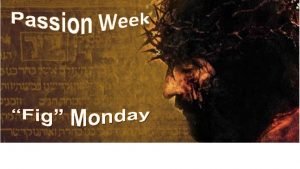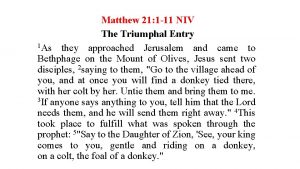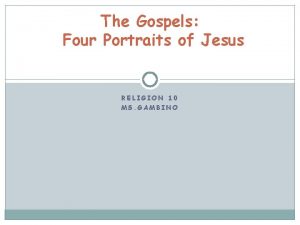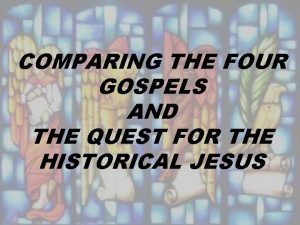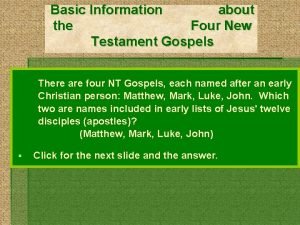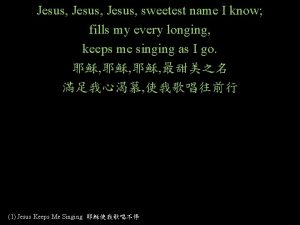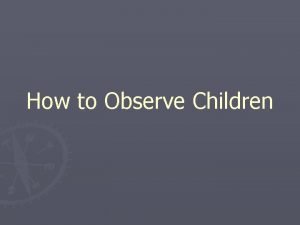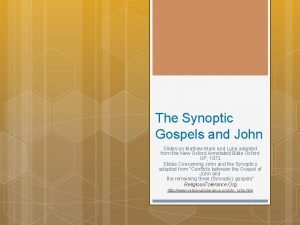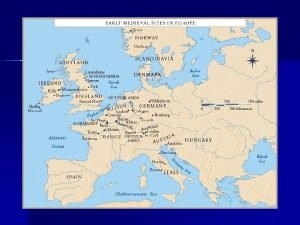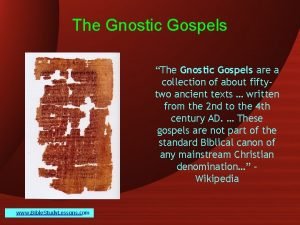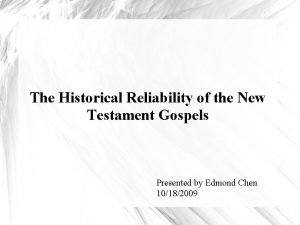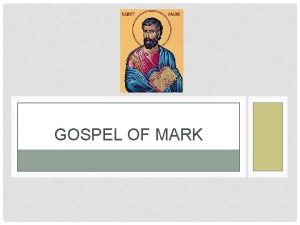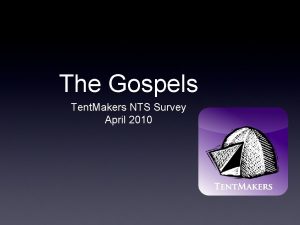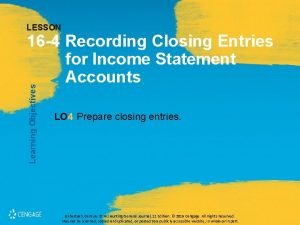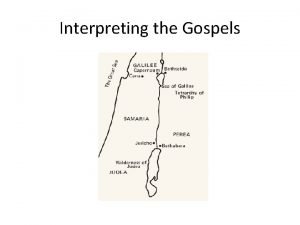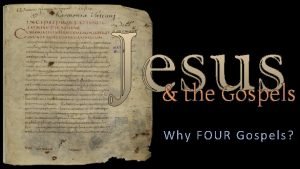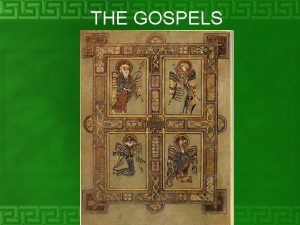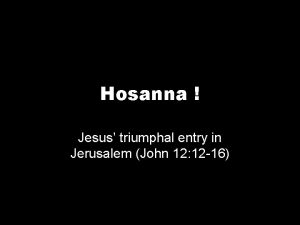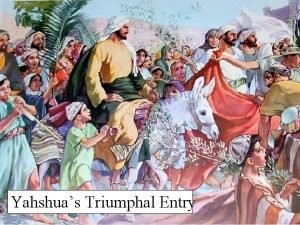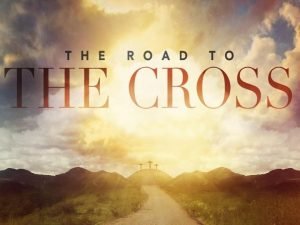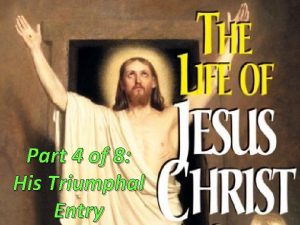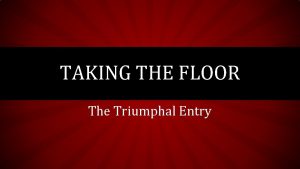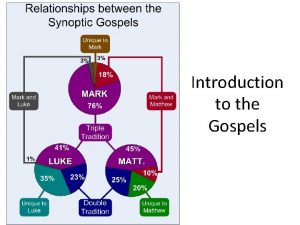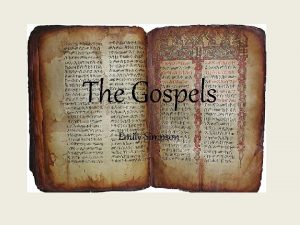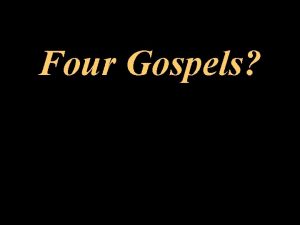All four gospels record Jesus triumphal entry into
























- Slides: 24


All four gospels record Jesus triumphal entry into Jerusalem on Sunday. After that, they diverge into differing accounts. It’s the same story, just different emphases, differing content and SLIGHTLY differing sequences. Remember, we are using Mark’s gospel as our guide.

All four gospels record Jesus triumphal entry into Jerusalem on Sunday. The best analogy might be four people riding in a car. Each person sees the exact same thing. But because they are different people: One notices the farm animals in the fields. One notices the houses in the woods. One notices the orchards and trees. One notices the different cars.

Mark 11: 12 -19 The next day as they were leaving Bethany, Jesus was hungry. Seeing in the distance a fig tree in leaf, he went to find out if it had any fruit. When he reached it, he found nothing but leaves, because it was not the season for figs. Then he said to the tree, "May no one ever eat fruit from you again. " And his disciples heard him say it. On reaching Jerusalem, Jesus entered the temple area and began driving out those who were buying and selling there. He overturned the tables of the money changers and the benches of those selling doves, and would not allow anyone to carry merchandise through the temple courts. And as he taught them, he said, "Is it not written: "'My house will be called a house of prayer for all nations'? But you have made it 'a den of robbers. '" The chief priests and the teachers of the law heard this and began looking for a way to kill him, for they feared him, because the whole crowd was amazed at his teaching. When evening came, they went out of the city.

Once again Mark gives us a “framed” event. Jesus throws a “temple” tantrum 11: 15 -19 Jesus curses the fig tree 11: 12 -14 Monday Fig tree withers 11: 20 -21 Tuesday

11: 12 -14 The next day as they were leaving Bethany, Jesus was hungry. Seeing in the distance a fig tree in leaf, he went to find out if it had any fruit. When he reached it, he found nothing but leaves, because it was not the season for figs. Then he said to the tree, "May no one ever eat fruit from you again. " And his disciples heard him say it. 11: 20 In the morning, as they went along, they saw the fig tree withered from the roots. Peter remembered and said to Jesus, "Rabbi, look! The fig tree you cursed has withered!" "Have faith in God, " Jesus answered. "I tell you the truth, if anyone says to this mountain, 'Go, throw yourself into the sea, ' and does not doubt in his heart but believes that what he says will happen, it will be done for him. Therefore I tell you, whatever you ask for in prayer, believe that you have received it, and it will be yours. And when you stand praying, if you hold anything against anyone, forgive him, so that your Father in heaven may forgive your sins. "

This is a peculiar story. The event takes place right before Passover (March/April). Fig trees in the Middle East would have put on leaves by this time of the year, but not fruit. Why then would Jesus have been upset when he found that the fig tree had no fruit? Did the events of this story really take place during Passover Week or have the evangelists transplanted it to make a point? Did Jesus know full well that the tree would be barren and use the incident to illustrate a point?

Let’s then think of the fig tree episode symbolically. The fig tree represents the temple. The ripe fig is often used symbolically for God’s people living the good life God expects from his people. Lamenting the perversity of the nation, the prophet Jeremiah said, “'I will take away their harvest, declares the LORD. There will be no grapes on the vine. There will be no figs on the tree, and their leaves will wither. What I have given them will be taken from them. ‘” - Jeremiah 8: 13

Let’s then think of the fig tree episode symbolically. The fig tree represents the temple. The lack of fruit says that the temple was not operating as God intended.

Let’s then think of the fig tree episode symbolically. The fig tree represents the temple. The lack of fruit says that the temple was not operating as God intended. Mark 11: 15 -18 – And they came to Jerusalem. And He entered the temple and began to cast out those who were buying and selling in the temple, and overturned the tables of the moneychangers and the seats of those who were selling doves; and He would not permit anyone to carry goods through the temple. And He began to teach and say to them, "Is it not written, 'My house shall be called a house of prayer for all the nations '? But you have made it a robbers' den. " And the chief priests and the scribes heard this, and began seeking how to destroy Him; for they were afraid of Him, for all the multitude was astonished at His teaching.

What was Jesus’ problem with the temple? Was it the blood sacrifice? Was it the priesthood? Was it the temple as a religious building?

BLOOD SACRIFICE Most ancients accepted blood sacrifice as the highest form of religious expression. – Why? Most people grew up around animals (even in the cities) and knew that to have meat, an animal must die. Two essential ways of creating, maintaining, or restoring fellowship: A gift, A meal.

BLOOD SACRIFICE The offerer took a valuable animal or food and burnt it on the altar. The smoke and smell rising symbolically represented the transition of the gift from earth to heaven. The meat became a sacrifice by having the blood poured over the altar and then returned to the offerer as a sacred meal with God. The animal sacrifice was a form of substitutionary atonement. Blood sacrifice was a normal element of worship in most religious ceremonies.

AMBIGUITY OF THE HIGH PRIEST When the Maccabean (166 BC) revolt installed the Hasmonean dynasty, the chief priesthood ceased to be hereditary. When Rome took over (63 BC), high priests were hired and fired at will by the Roman governors. All were drawn from four families. Remember that Roman imperial power ruled with the cooperation of the local population. Judea was a little different in that the Roman governor could not be a priest. Because there were four families in competition with each other, the Romans played them off against each other.

AMBIGUITY OF THE HIGH PRIEST Caiaphas was high priest from 18 -36 AD and Pilate was governor from 26 -36 AD, so we must assume that the two them worked together fairly well. of It was possible in Jesus’ day to be against the high priest without being against the high priesthood. The high priest represented the people before God on the Day of Atonement, and represented Rome the rest of the year.

AMBIGUITY OF THE TEMPLE The ambiguity of the high priest spilled over on to the temple. Every Jew adored and supported the temple. The temple tax of two denarii (or two days work) was not onerous. Jews jealously guarded their temple. When Emperor Caligula tried to install a statue of Zeus within the temple grounds, huge crowds of people physically block the installation process with their bodies.

What was Jesus’ problem with the temple? Was it the blood sacrifice? Was it the priesthood? Was it the temple as a religious building? None of the above! Recall that one of Jesus’ passions was the Kingdom of God. The temple was the center for the “domination system” erected by the Romans and orchestrated by the high priest and other authorities connected with the temple.

Let’s then think of the fig tree episode symbolically. The fig tree represents the temple. The lack of fruit says that the temple was operating as God intended. not The scene of the “temple tantrum” was probably the southern porch known as the “Royal Porch. ” This would have been close to the Ophel Gate on the southern end of the temple mount which would see a lot of traffic as worshipers came and went.

Let’s then think of the fig tree episode symbolically. The fig tree represents the temple. The lack of fruit says that the temple was operating as God intended. not The practice of exchanging money and buying sacrificial animals in the Courts of the Gentiles did have a certain efficiency about it. All of the needs of a worshiper could be satisfied in one place at one time (with a handsome profit for the merchants and the priests).

Let’s then think of the fig tree episode symbolically. The fig tree represents the temple. The lack of fruit says that the temple was not operating as God intended. Jesus was more concerned with where the buying and selling was taking place than the actual practice itself. Jesus’ anger was directed more against the priestly establishment for allowing the practice of conducting business in the temple than the actual merchants.

Let’s then think of the fig tree episode symbolically. The fig tree represents the temple. The lack of fruit says that the temple was not operating as God intended. When Jesus disrupted the buying and selling, it only affected a small portion of the temple area. The temple mount covered nearly 33 acres. Jesus was able to suspend commercial activity in a portion of the temple complex. Still, the religious authorities thought it would be best if Jesus were to die.

Let’s then think of the fig tree episode symbolically. The fig tree represents the temple. The lack of fruit says that the temple was not operating as God intended. The withering (Tuesday in Mark’s gospel) foreshadows the destruction of the temple by Titus in 70 AD.

Let’s then think of the fig tree episode symbolically. The withering (Tuesday in Mark’s gospel) foreshadows the destruction of the temple by Titus in 70 AD. The withering tree is symbolic of God’s coming judgment on Israel. Joel 1: 7 - It has laid waste my vines and ruined my fig trees. It has stripped off their bark and thrown it away, leaving their branches white. Hosea 2: 12 I will ruin her vines and her fig trees, which she said were her pay from her lovers; I will make them a thicket, and wild animals will devour them.

Jesus and his friends leave Jerusalem for the day and return to Bethany.
 Is the triumphal entry in all four gospels
Is the triumphal entry in all four gospels Triumphal entry luke
Triumphal entry luke Matthew 21:1-11 niv
Matthew 21:1-11 niv 4 portraits of jesus
4 portraits of jesus Bema judgement meaning
Bema judgement meaning Comparing the four gospels
Comparing the four gospels Four new testament gospels
Four new testament gospels Jesus jesus jesus sweetest name i know
Jesus jesus jesus sweetest name i know Jesus in the morning
Jesus in the morning Anecdotal record vs running record
Anecdotal record vs running record The date
The date St matthew ebbo gospels
St matthew ebbo gospels Gnostic gospels summary
Gnostic gospels summary The virgins memo genius
The virgins memo genius The historical reliability of the gospels
The historical reliability of the gospels Chi rho iota page from the book of kells
Chi rho iota page from the book of kells Synoptic gospels
Synoptic gospels List the synoptic gospels
List the synoptic gospels Sunoptic gospels
Sunoptic gospels Gospels
Gospels Sunoptic gospels
Sunoptic gospels Journal closing entries
Journal closing entries Record the closing entry for dividends
Record the closing entry for dividends Single entry system definition
Single entry system definition New entry in entrepreneurship
New entry in entrepreneurship
